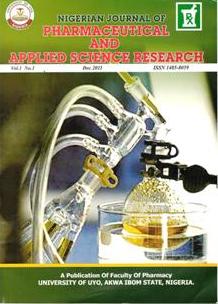Evaluation and Modelling of Shallow Subsurface Temperature in Parts of Akwa Ibom State, Nigeria.
Main Article Content
Abstract
Background: Soil temperature is one of the most important factors affecting plant growth. Until soil reaches a certain critical temperature neither seeds germinate nor plants have a normal growth because it affects root and shoot growth and availability of water and nutrients.
Methods: Temperature measurements have been carried out at different depths in the soil in parts of Akwa Ibom State of Nigeria. Different locations were chosen, (Ikot Obong Edong, Ikot Otu, Abiakpo). Results of measurements were taken from different depths and different time with the aid of a soil thermometer over a period of one year. The diurnal soil temperature cycles are being modelled with fairly good accuracy. Differences in measured and modelled soil temperatures are determined at daily levels at depths 0cm which is the top soil, 10cm, 30cm and 50cm.
Results: The daily soil temperature ranges from 29.7? – 42.9? for months covering dry season with a simple mean of 36.3?; 21.2?– 29? for months covering rainy season with a simple mean of 25.1. The mean temperature for all season is 30.7?, indicating that these locations are favourable for farming.
Conclusion: The results can be valuable in planning and developing soil tillage practices and other agricultural activities in the areas studied. It was found that in dry season, the soil temperature increases with depth and in rainy season, it first decreases up to certain depth and then starts to increase with depth. This is due to the effects of solar thermal energy and ground thermal energy.
Downloads
Article Details

This work is licensed under a Creative Commons Attribution-NonCommercial-NoDerivatives 4.0 International License.
References
Barer LD. Soil Physics. Freeman Copper and Co; 1972. p. 253-80.
DeVries DA. Heat transfer in soils. In: D.A. Farouki, editor. Pages 5-28; 1975.
Farouki OT. The thermal properties of soils in cold regions; 1981.
Gupta SC, Larson WE, Allmaras RR. Predicting soil temperature and soil heat flux under different tillage-surface residue conditions. Soil Sci Soc Am J. 1984; 48:223–32.
Hillel D. Fundamentals of Soil Physics. Academic Press; New York: 1980.
Kristinsson H, Sigurdsson SV. A guide to the flowering plants and ferns of Iceland. 3rd ed. Reykjavik, Iceland: Mál og Menning; 2010. p. 311.
Li J, Carlson BE, Lacis AA. A study on the temporal and spatial variability of absorbing aerosols using total ozone mapping spectrometer and ozone monitoring instrument aerosol index data. J Geophys Res. 2009; 114: D09213. doi:10.1029/2008JD011278.
Lloret F, Penuelas J, Estiarte M. Experimental evidence of reduced diversity of seedlings due to climate modification in a Mediterranean-type community. Global Change Biol. 2004; 10:248–58.
Marcante S, Erschbamer B, Buchner O, Neuner G. Heat tolerance of early developmental stages of glacier foreland species in the growth chamber and in the field. Plant Ecol. 2014; 215:747–58.
Natural Environmental Research Council (NERC). Temperature and Thermal Properties (Detailed). British Geological Survey report No: GR_999999/1; 2011. p. 1-7.
Nwankwo CN, Ogagarue DO. An investigation of temperature variation at soil depths in parts of Southern Nigeria. Am J Environ Eng. 2012; 2(5):142-7.
Ogunlela AO. Modelling Soil Temperature Variations. J Agric Res Develop. 2003; 2(1):1-10.
Paudel J, Jaman S, Shrestha KK. Transforming land and livelihoods: Analysis of agricultural land abandonment in the mid-hills of Nepal; 2012.
Penrod EB, Elliot JM, Brown WK. Soil temperature variation (1952-1956) at Lexington, Kentucky. Soil Sci. 1960; 5:275-83.
Rose CW. Agricultural physics. Pergamon, Oxford; 1966. p. 230.
Schwienbacher E, Navarro-Cano JA, Neuner G, Erschbamer B. Correspondence of seed traits with niche position in glacier foreland succession. Plant Ecol. 2012; 213:371–82.
Sun J, Zhang K, Wan H. Impact of nudging strategy on the climate representativeness and hindcast skill of constrained EAMv1 simulations; 2019.
Taylor SA, Jackson RD. Heat capacity and specific heat. In: Black CA, editor. Methods of soil analysis. American Soc Agron Monogr. 1976; 9:345-8.


